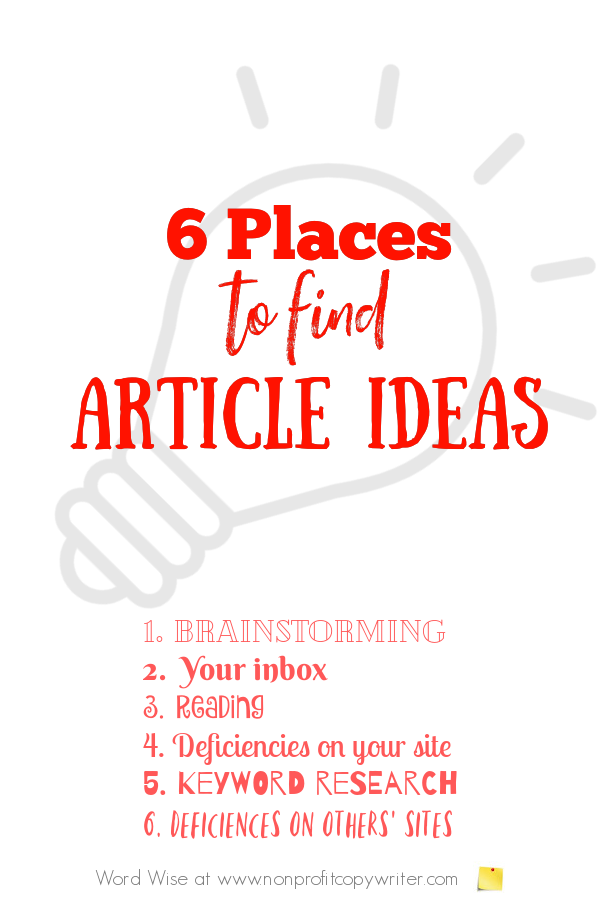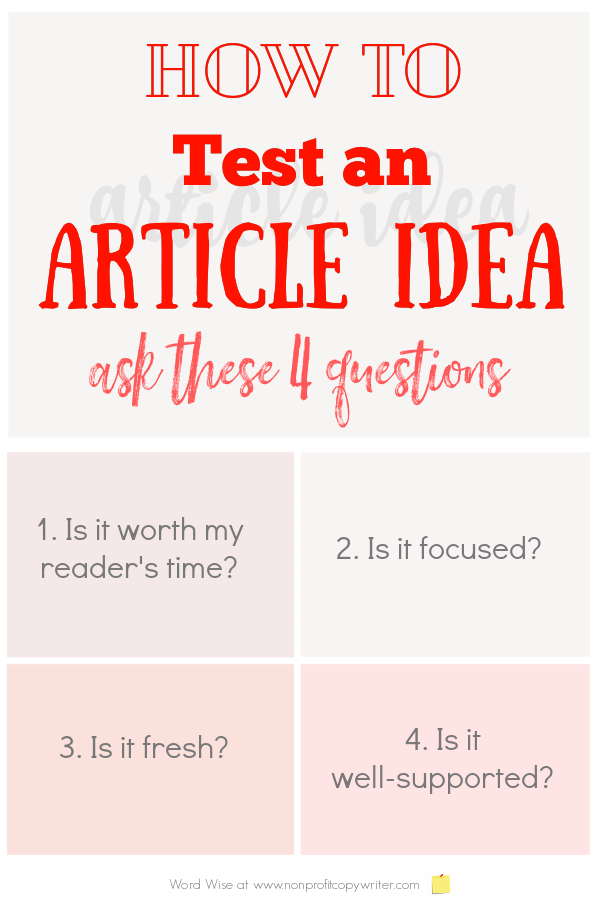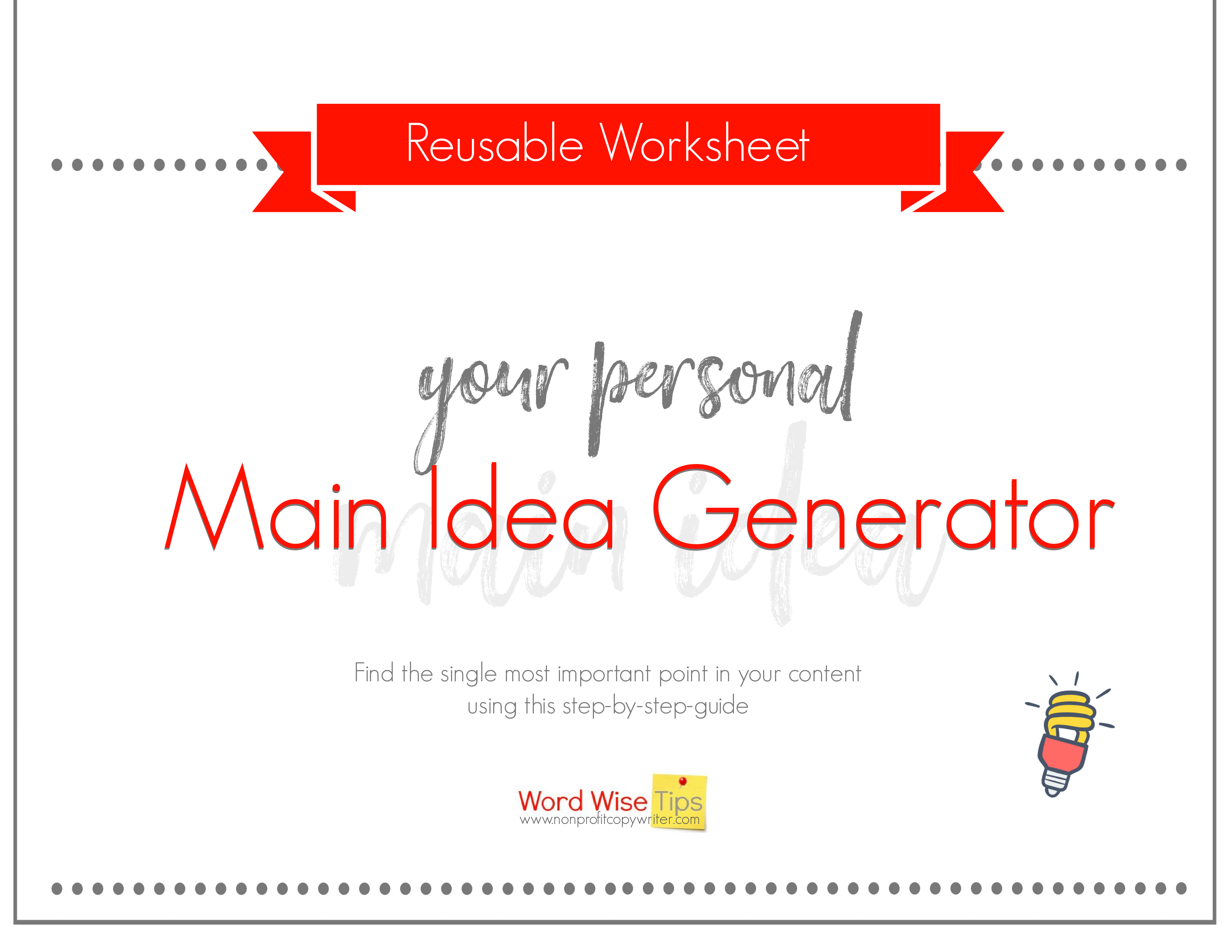Save Time: Get 5 Simple Writing Tips
you can put to use in 10 minutes
How To Test an Article Idea
Award-winning writer Kathy Widenhouse has helped hundreds of nonprofits and writers produce successful content , with 750K+ views for her writing tutorials. She is the author of 9 books. See more of Kathy’s content here.
Posted 4.5.25
Every week, I write at least one new article for one of my websites.
That means each week I choose an article idea, test it, and then toss it back into the pile … or proceed with writing it.
I’ve not always been so careful when starting a new piece of content. My writing files are littered with half-baked article attempts, temporarily abandoned.
As a result, I’ve learned not to rush over this first step in writing new content. When I take the time to test an article idea before jumping into the first draft, writing the article goes faster. Even better — the content provides value for my reader.
I start with a list of article ideas
I start with a list of article ideas
I keep a running list of article ideas for each of my websites. I gather these ideas from …
- Brainstorming
- Phrases or headlines I see in my inbox
- Reading other writers’ content (I find inspiration from different viewpoints)
- Studying my website to see what information is lacking
- Keyword research
- Topics I’d like to see other writers write about
At any point, I’ve got 50–100 article ideas on my master lists. When it’s time to write, I read through my ideas and see what tugs at my interest. One week I may skim over an idea only to latch onto it a month later.
Once an idea catches my eye, I check to ensure I haven’t written a page on my site about the same topic. If similar content is there, I throw out the idea. (Please don’t judge. My sites have hundreds of pages, and I cannot always remember what I wrote 8 years ago.)
Then I ask myself a few questions.
4 questions I ask to test an article idea
1. Is this article idea worth my reader’s time?
Will an article centered on my idea make a difference for my readers? The answer must be “Yes,” or I don’t proceed. By “make a difference,” I mean the article answers a question, solves a problem, or inspires an action for my readers. I need to make sure that I’m not just writing the article to throw more content onto my site. My readers will invest time reading it. I want to give them a solid ROI for their effort.
I find a simple fill-in-the-blanks template useful in determining whether or not an article can offer value:
This article will explain to [short description of your readers] [your article idea].
Let’s look at an example. Maybe you write about home bird watching. You’re getting ready to write this week’s article and from your list of ideas, you pluck this one: clean your bird feeders.
So, you fill in the template:
This article will tell home bird watchers to clean their bird feeders.
Does this idea make a difference for these bird lovers? Probably not too much. They see the grime and goop accumulate on their feeders and know they must clean them. So I go back and beef up my article idea a bit.
This article will tell home bird watchers why to clean their bird feeders, when to clean them, and how to clean them.
Bingo! This article idea offers value for home birders by giving them practical information they need to have healthy bird stations in their yards.
2. Is this a focused article idea?
I’ve hit on a meaningful article idea. But is it manageable? “A big idea is one with lots of significant consequences,” says writer Josh Bernoff. “A small idea has only a few, localized consequences.”
I’ve already determined that my article idea, when fleshed out, will add value for my reader. But both big ideas and small ideas can be consequential. Which is mine?
A big idea can be too broad to cover in a single article or possibly even in a book. Imagine what would happen if I tried to write a comprehensive post on every type of bird you should look for at your home bird feeder. The article would be weak at best — but assuredly incomplete.
With that in mind, I test my article idea to see if it has just one or two clear consequences for the reader.
My site’s big idea is that anyone can attract birds to their backyard by following fundamental birding tips like choosing bird feeders, understanding different types of bird seed, knowing migration patterns, identifying plumage, recognizing bird calls, recording sightings … and yes, keeping feeders clean.
Keeping feeders clean is a smaller idea that targets few clear outcomes. A clean feeder means more birds, less bird seed loss, and healthier plant life in your yard. And it’s a principle that contributes to the overall website’s big idea.
But is the idea narrow enough? I’m not sure I can do justice in a single article explaining why, when, and how to clean 3 different types of the most popular bird feeders: seed feeders, suet feeders, and hummingbird feeders. Each of the different types of feeders is very different and requires different maintenance.
My article idea is still a bit broad — even if I’m aiming for a long-form content piece of 1,500–2,000 words. In other words, there are more than one or two practical outcomes readers can gain from my projected piece of content.
So by asking, “Is this a focused article idea? I drill down further. I’ll focus on just one type of feeder. I decide this article will tell home bird watchers why to clean their suet bird feeders, when to clean them, and how to clean them. Later, if I choose, I can write articles about how to clean the other types of feeders.
Use this worksheet to find your main idea for any piece of content.
3. Is this a fresh article idea?
“There’s nothing new under the sun,” wrote King Solomon (971 BC- 931 BC). I come back to this principle over and over — especially when I’m riding high on a creative cloud, misbelieving I have finally hit upon an original article idea.
The truth is that I have never had a 100% bona fide unique article idea. What’s unique is how I package the idea.
Early in my writing life, I wrote an article that tackled the frustrations of Christmas gift-giving. The gist of the article: giving gifts to so many family members costs too much and creates a panicked rush each December. That principle is nothing new. But I used the article to explain how I look for deals all year long, purchase gifts from January through November, and store them on my Christmas shelf. Cherry Picking for Christmas was published and republished in more than a dozen magazines. “You’ve taken a timeworn topic and given it a fresh slant,” one editor told me.
Truths remain constant over time, but their presentation has an infinite number of variations. My article idea may not be original, but can I validate it with a creative angle or an innovative viewpoint? “Yes” must be my answer to that question, or I won’t proceed.
4. Is this a well-supported article idea?
By now in my testing process, I’m holding my breath. I’ve got what I think will be a worthwhile read for my audience — one that has a focused main point, packaged in a unique way. But can I support my point?
Here’s where I take an inventory of evidence and quotes from experts. Stories and examples. I’ve got to have them so I can provide a convincing argument. A weak article idea has little to no factual or anecdotal support. It’s heavy on preaching and theory, and light on examples and stories. If I don’t have enough research to back up my idea, then I find it — or the idea goes onto the discard pile.
Testing my article idea makes writing easier
Writing is a set of three different activities: processing ideas, writing a draft, and editing. Testing an article idea fits squarely in the “processing ideas” bucket.
At times I skip this step. And the results are disastrous. My messy first draft turns into an excruciating exercise in chaos. I don’t have a clear idea of what I want to say … I lack purpose in making my point because I don’t have one … my examples are hackneyed. My writing time starts and stops while I attempt to find facts and quotes to back up my non-existent point.
But when I validate my article idea, then I find I can move to writing the draft easily. I’ve defined what my article will accomplish and the packaging I’ll use to wrap up the message tidily — whether it’s a listicle or a product review or a profile feature.
Frankly, testing an article idea takes time. But in my mistaken rush to produce good content, I’ve learned an important lesson. When I take time to validate my article idea, I save time in the long run.
More Article Writing Tips
Where to Look for Writing Ideas ...
The 2 Best Ways to Narrow Your Topic for an Article...
Choose a Story Angle Using These 3 Tips ...
Test Your Book Idea With These 4 Questions
How to Narrow Your Article Main Idea ...
How to Develop a Story Idea ,,,
How to Choose an Article Topic...
How to find the main idea of your article before you write ...
Tips about the Writing Process on our Pinterest board ...
Return from How To Test an Article Idea to Nonprofit Copywriter home
As an Amazon Associate I earn from qualifying purchases.
Share This Page

Named to 2022 Writer's Digest list
BEST GENRE/NICHE WRITING WEBSITE


Stop Wasting Time!

Grab your exclusive FREE guide, "5 Simple Writing Tips You Can Put to Use in 10 Minutes or Less"













